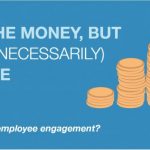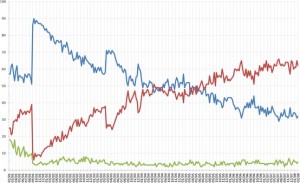Math is like a reflex – we use it without thinking about it. Despite what your school teachers may have told you, your most often use of mathematics is not in adding/subtracting numbers – it’s actually in making decisions. This is the topic of today’s Skew, with the help of this comic. Real-world math is most often applied through the guise of what economists call “expected costs.” This is the cost of some risk which has some chance of happening.
Quick ex ample, let’s say that you and a friend are betting $100 on a coin flip. You call heads, he calls tails. Since there’s an equal chance for heads or tails, the likelihood that you win is equal to the likelihood that you lose – 50%. So, assuming the winner gets all of the money, your expected cost is the likelihood that you lose (50%) multiplied by the value of what’s at stake ($100). So, the expected cost is $50 in this example (and equal to your expected gain, so the bet is essentially a wash between risk and reward).
ample, let’s say that you and a friend are betting $100 on a coin flip. You call heads, he calls tails. Since there’s an equal chance for heads or tails, the likelihood that you win is equal to the likelihood that you lose – 50%. So, assuming the winner gets all of the money, your expected cost is the likelihood that you lose (50%) multiplied by the value of what’s at stake ($100). So, the expected cost is $50 in this example (and equal to your expected gain, so the bet is essentially a wash between risk and reward).
The “funny” in the comic is in the assumptions that the guy is making to base his decisions. He’s saying that the expected cost of a terrorist attack exceeds just about any price. At the same time, he’s saying the opposite about a car accident – the expected cost is so low that any price would likely be too expensive. Since there are two pieces of information that drive these expected costs – the probability of the thing happening, and the cost resulting from that thing happening – then we can actually test how rational these two decisions are when taken together.
By most estimates, the probability that this guy dies in a terrorist attack is around 1 in 20 million. His odds of dying in a car accident? About 1 in 30,000. So, unless the cost of those personal safety features is more than 600 times greater than the personal cost of terrorist attack prevention, then it should make no sense for him to be more willing to ignore the safety features if he’s willing to pay to prevent attacks (there are other costs associated with both of these events, but I’m looking at it from a personal level only).
The key word there is “should.” In reality, we tend to inflate/deflate the odds of events pretty dramatically, which affects our behavior. Acts of terror are designed specifically to promote fear and inflate the perceived risks, while at the same time everyone thinks that they are the safest driver in the world. Also, we have remarkably little information about the actual costs associated with our daily risks, adding a layer of uncertainty in the decision-making process and ultimately clouding our judgment. In fact, if we had complete information about everything, then donuts and bacon would be given away almost for free, and bottles of water would become incredibly expensive.
In short, while math can (and a lot of times does) help to lead us toward rational decisions; it can also cause us to be irrational at times. However, the irrational decisions are still driven by solid math. They’re just informed by our own (often unsound) assumptions. By understanding those assumptions, we can account for the way they skew the decision-making process.





